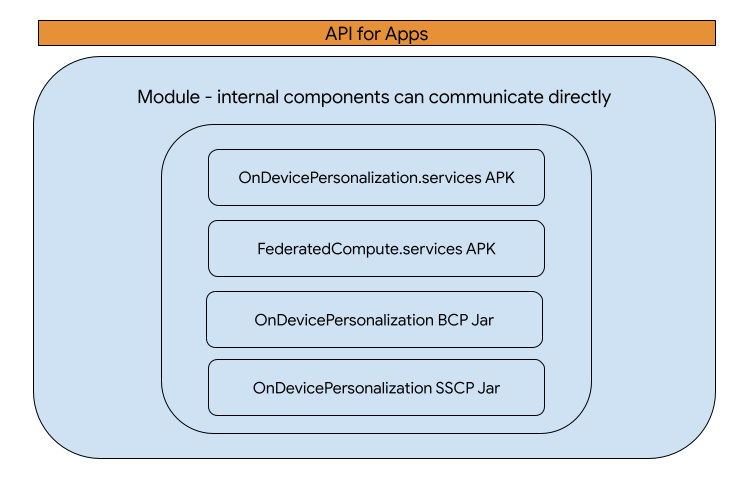โมดูล OnDevicePersonalization ซึ่งเปิดตัวใน Android 13 มีชุดบล็อกการสร้างที่พัฒนาขึ้นโดยมีหลักการสำคัญคือความเป็นส่วนตัวของผู้ใช้ เพื่อรองรับการพัฒนา APK ที่มอบประสบการณ์การใช้งานที่ปรับตามโปรไฟล์ของผู้ใช้ ตัวอย่างขององค์ประกอบพื้นฐานที่ให้ไว้ ได้แก่ เครื่องมือนโยบาย เพื่อป้องกันการรับ การส่งออก และการดำเนินการที่อนุญาตในรายการของข้อมูลผู้ใช้ การควบคุมของผู้ใช้ สามารถแสดงเป็นนโยบายที่บังคับใช้โดยเครื่องมือนโยบายนี้ อีกตัวอย่างหนึ่งของบล็อกการสร้างที่ให้ไว้ ได้แก่ การคำนวณแบบรวมต่างๆ เช่น Federated Learning และ Federated Analytics ซึ่งช่วยให้การฝึกโมเดลแมชชีนเลิร์นนิงและการวิเคราะห์ข้อมูลดิบในเครื่องเป็นไปได้โดยไม่ต้องรวบรวมข้อมูลจากส่วนกลาง
OnDevicePersonalization พยายามสร้างประสบการณ์การใช้งานสำหรับนักพัฒนาแอปที่ช่วยลด ปัญหาคอขวดที่เกิดจากการเก็บรวบรวมข้อมูล ความยินยอม การควบคุม และการปฏิบัติตามข้อกำหนด ซึ่งช่วยให้ OEM และนักพัฒนาแอปมุ่งเน้นไปที่ส่วนใหม่และส่วนที่น่าสนใจในเชิงความหมายของแอปพลิเคชัน และใช้ประโยชน์จากข้อมูลแบบเรียลไทม์ที่มีความสมบูรณ์สูงซึ่งมีให้บริการในอุปกรณ์เท่านั้น
แรงจูงใจ
เป้าหมายของโมดูลการปรับเปลี่ยนในแบบของคุณบนอุปกรณ์คือการสร้างเทคโนโลยีใหม่เพื่อ ช่วยให้ OEM และนักพัฒนาแอปสามารถมอบประสบการณ์การปรับเปลี่ยนในแบบของคุณที่มีคุณภาพ แก่ผู้ใช้ปลายทางต่อไปได้ในขณะที่ยังคงรักษาข้อมูลของผู้ใช้ให้เป็นส่วนตัว
ขอบเขตของโมดูล
นี่คือโค้ดใหม่ทั้งหมดที่ไม่มีขอบเขตของโมดูล
ตำแหน่งของโค้ด: packages/modules/OnDevicePersonalization
รูปที่ 1 แสดงการออกแบบ API ของโมดูล OnDevicePersonalization

รูปที่ 1 การออกแบบ API ของโมดูล OnDevicePersonalization
รูปแบบแพ็กเกจ
ฟังก์ชันการทำงานหลักของแพ็กเกจจะอยู่ใน APEX
com.google.android.ondevicepersonalization
ฟังก์ชันการทำงานของ OnDevicePersonalization API จะพร้อมใช้งานใน APK
com.google.android.ondevicepersonalization
ฟังก์ชันการทำงานของ FederatedCompute API จะพร้อมใช้งานใน APK
com.google.android.federatedcompute
การขึ้นต่อกัน
- การเปลี่ยนแปลงใน PackageManager เพื่อตีความแท็ก Manifest ใหม่

